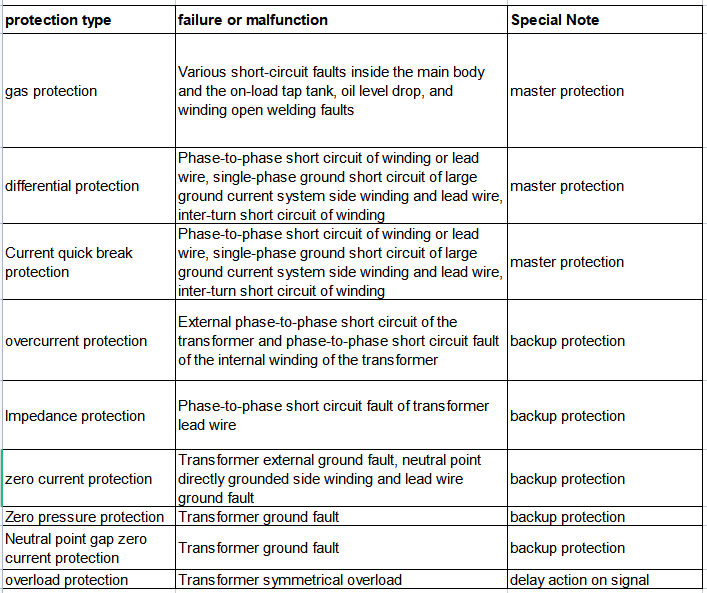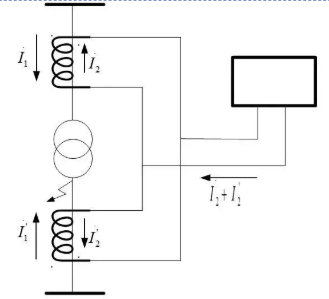Transformer faults can be divided into internal faults and external faults.
Transformer internal faults refer to the faults that occur in the transformer oil tank, including phase-to-phase short circuit of each winding, inter-turn short circuit of winding, short circuit fault between winding and iron core, single-phase grounding fault of single-phase winding or lead-out wire passing through the shell, winding disconnection fault, etc. Transformer external faults refer to various faults that occur on the external insulating bushing of the transformer oil tank and its lead-out wires, including single-phase grounding short-circuits and phase-to-phase short-circuits between lead-out wires caused by flashover or broken insulating bushings.
In addition, there are several abnormal working conditions of the transformer, mainly including low oil level, high oil temperature or pressure, high transformer neutral point voltage, overload, overcurrent, overexcitation, etc.

In order to monitor different faults or abnormal working conditions, we have set up different protections, which are divided into main protection and backup protection, and the main protection has quick action characteristics.
Part 2: Differential protection
The longitudinal differential protection is one of the main protections of the transformer, and the protection operates instantaneously to trip the switches on each side. The protection area is the part between the current transformers on each side of the differential protection, including the transformer body, the lead-out lines between the current transformer and the transformer. In 2017, the arrester on the 35kV side of the No. 2 main transformer of a 220kV substation had an AB phase flashover, and the arrester chassis was broken down by discharge; because the 35kV arrester was located between the rheological transformer and the main transformer on the low-voltage side of the main transformer, it was within the protection range of longitudinal difference. The two sets of main transformer protections all acted correctly, and the fault was isolated.
01
Basic logic of differential protection
The existing transformer longitudinal differential protection adopts microcomputer protection device, and the current of each phase enters the protection device respectively, and the longitudinal differential protection is realized by software algorithm. We take one phase as an example to illustrate the basic principle of longitudinal differential protection.
The differential current "felt" by the protective device is the vector sum of the secondary currents of the two coils. As shown in Figure 1, when the system is operating normally or is short-circuited externally, the secondary currents of the two coils are the same in size and opposite in polarity, and the differential current is 0, and the protection does not operate at this time. As shown in Figure 2, when a ground fault occurs within the protection range, the secondary currents are equal in size and polarity, and the differential current is the sum of the secondary currents. When the differential start value is reached, the protection operates.


On the basis of the rheological secondary coil connection method above, the longitudinal differential protection adds phase adjustment, zero-sequence current elimination, and amplitude conversion to the current vectors on different sides to form a differential current calculation method, and then introduces the ratio braking characteristic curve. Constitute the basic logic of protection.
Taking YN-d11 wiring as an example, the wiring diagram and current phasor diagram are shown in Figure 3. It can be seen that because there is a 30° angle difference between the high and low side phasors, the vector sum of the two currents is not 0 during normal operation, and the phase conversion is required first. After the conversion, the high and low sides of the same phase have the same phase.

There are two methods of phase conversion, one is based on the Y side, so that the d-side current phase is consistent with the Y-side current phase, referred to as "angle star", the most common angle star protection is Narui Jibao RCS-978 etc., the conversion formula is:

The other is based on the side d, so that the current phase of the Y side is consistent with that of the d side, referred to as "star rotation angle". Most of the existing protection devices adopt the star rotation angle method, and the conversion formula is:

The purpose of zero-sequence current elimination is to prevent misoperation of longitudinal differential protection. For YN-d wiring, when a ground fault occurs outside the high-voltage side, zero-sequence current flows on the high-voltage Y side, but there is no zero-sequence current on the low-voltage d side, and the zero-sequence currents on both sides cannot be balanced, so the differential protection will malfunction . In the "star rotation angle" conversion mode, the difference between the two currents after the phase shift on the Y side has filtered out the zero current, so no measures need to be taken. In the "angle-to-star" conversion mode, the zero-sequence current compensation is performed on the Y-side current vector, and the compensation formula is:

Due to the difference in the transformation ratio of the transformer and the rheological transformation ratio of each side, the secondary amplitude of the differential current on each side of the transformer cannot be the same during normal operation or external fault. At this time, it is necessary to perform amplitude conversion, take the current value on one side as a reference, calculate the balance coefficient on the other side according to the voltage on both sides and the rheological ratio, and multiply the current on the other side by the balance coefficient, so that the internal calculation of the device Differential flow is 0.
In order to further improve the action sensitivity in the case of internal faults and reliably avoid the unbalanced current of external faults, the longitudinal differential protection adopts a differential element with a ratio braking characteristic curve. The vertical axis of the ratio braking curve is the differential current, the horizontal axis is the braking current, the upper part of the curve is the action area, and the lower part is the braking area. The existing characteristic curves are mainly divided into two types: two-segment broken-line type and three-segment broken-line type.
The two-segment broken-line ratio braking curve is shown in the left figure of Figure 4. The curve can be ABC type that passes through the origin, or ABD type that does not pass through the origin. Most devices are ABC type.

The three-segment broken-line ratio braking curve is shown in the right figure of Figure 4, which can be subdivided into two types, one is the horizontal line for the AB segment, and the other is the oblique line for the AB segment. The equipment with the horizontal line in the AB section includes Guodian Nanzi PST-1200U, ABB's RET-316, Xuji WBH-801 and SEL-387, and the equipment with the oblique line in the AB section includes Sifang CSC-326, Shenrui PRS-778 and South Swiss RCS-978.
02
How to check the differential protection
The longitudinal differential protection protection verification is carried out according to the ratio braking characteristic curve, the protection above the curve operates, and the protection below the curve does not operate:
1) Pick a point. Select 3-5 points for longitudinal differential protection verification, the first point is selected on the vertical axis of Figure 4 to verify the minimum operating current Iop.min; the second and third points are selected on the inflection point to verify the inflection point current Ires; in addition, Pick a point on each slope to verify the slope.
2) Calculate the value. Calculate the start-up value current, balance coefficient, and balance of each side of the transformer; then calculate the current magnitude and phase angle of each side of each check point according to the ratio braking curve of the device.
3) Verify the curve. Apply the fixed variable method to fix one current in the check point and change the size of the other current, so as to move the check point up and down to the action area and braking area to verify whether the protection device operates correctly.
03
Auxiliary components for differential protection
In order to make the differential protection more reliable, the protection logic also involves components such as start, quick break, and lock:
1) Starting element: The starting variable includes the maximum value of three-phase differential current, the amount of current mutation, etc. When the starting variable is greater than any starting value, the protection device opens the differential protection.
2) Differential quick-break element: At a high short-circuit current level, due to the saturation of the current transformer, the second harmonic generates a huge braking torque and the differential element refuses to move. In order to avoid protection refusal, a differential quick-acting element is installed in the device. When the short-circuit current reaches 4~10 times the rated current, the quick-acting element quickly moves to the outlet. In addition, in order to prevent incorrect action of the protection due to the inconsistency of the transient characteristics of the current transformers on each side when there is a large short-circuit current, the relevant characteristics of the current transformers on each side of the differential protection of the main equipment including transformers should be consistent (Eighteen Countermeasures 15.1. 10). The high-voltage side of the No. 2 main transformer of a substation is connected to the second string of 2/3 wiring, and this string is connected to another tie line; in 2017, a single-phase ground fault occurred on phase B of the switch in the string, and two sets of differential protection for the main transformer body The quick-break element operates to cut off the switches on each side of the main transformer; the split-phase current differential protection on both sides of the tie line cuts off the B phase of the corresponding side switch, and then the single-phase reclosing succeeds.
3) Exciting inrush blocking element: When the airdrop transformer and the short circuit outside the transformer area are cut off, a huge exciting inrush current will be generated. In order to prevent the differential current caused by the exciting inrush current from causing the device to malfunction, an inrush current blocking element is set up for the longitudinal difference protection, using waveform distortion ( Intermittent or asymmetric differential current waveform), harmonic component identification (second or third harmonic content), fuzzy identification identification of excitation inrush current. However, when the transformer is actually airdropped, especially for the first airdrop, the differential protection will still malfunction due to insufficient degaussing of the main body, and the harmonic content of the airdropped differential current may be lower than the harmonic component blocking threshold. In order to fundamentally eliminate the influence of residual magnetism on transformer empty charging, we can take degaussing measures and perform another empty charging, or temporarily lower the second harmonic blocking threshold to ensure the normal operation of the main transformer.
4) CT disconnection element: When the secondary phase of the CT is disconnected, the differential current is the load current of the disconnection phase, and the protection may malfunction. At this time, the zero-sequence current, phase current changes, abnormal sudden drop of phase voltage, etc. can be used to judge CT disconnection.
5) CT saturation blocking element: When an external fault occurs, CT saturation will cause differential protection to malfunction, so the protection device is equipped with a CT saturation blocking detection element. When the CT is saturated, the differential current occurs after the CT is saturated for a period of time, so the device uses the timing consistency of the braking current and the differential current to judge whether the CT is saturated. In addition, in order to minimize the impact of CT saturation on transformer longitudinal differential protection, current transformers with accurate limit factor (ALF) and higher rated inflection point voltage (18 item countermeasures 15.1.12).
Part 3: Introduction to other differential protection
1.
split side differential protection
The split-side differential protection is a differential protection that takes the Y-side winding of the transformer as the protected object, and is composed of the first and last CTs of the windings on each side according to the phase. Taking the self-coupling phase A in Figure 5 as an example, the protection is composed of TA1A, TA2a' and TA3A. According to Kirchhoff's current law, there is no electromagnetic coupling relationship between the currents at both ends, so the protection does not require inrush current blocking elements, differential snap-action elements and over-excitation blocking elements. In addition, the fixed value of the operating current of the split-side differential protection is lower, and the sensitivity is higher than that of the longitudinal differential protection. But the disadvantage of this protection is that it cannot protect inter-turn short circuit.

2.
Split phase differential protection
Phase-splitting differential protection is a differential protection that takes each phase winding of the transformer as the protected object, and is composed of CTs on each side of each phase winding. example). This protection can reflect all faults of a certain phase of the transformer except the low-voltage side leads, but an inrush current blocking element is required.
3.
Cell differential protection on the low voltage side
Since the phase-splitting differential protection has no protection range for the lead wires on the low-voltage side, the cell differential is introduced as a supplement to the phase-splitting differential. The differential protection of the low-voltage side community is composed of the internal CT of the triangular two-phase winding on the low-voltage side and the CT reflecting the differential current of the two-phase winding. Inrush blocking element, but does not respond to turn-to-turn faults.
4.
Zero sequence differential protection
The zero-sequence differential protection consists of zero-sequence current transformers on the neutral point side of the transformer and zero-sequence circuits of the current transformers on the star side of the transformer. Figures 6 and 7 are the current loops when ground faults occur outside the zone and inside the zone, respectively. Similarly, the secondary currents of this protection have no electromagnetic coupling relationship, so the protection device does not need an excitation inrush current blocking element or an over-excitation blocking element; at the same time, it is more sensitive to the grounding fault of the transformer winding. However, the zero-sequence differential protection can only reflect the internal ground fault of the high and medium voltage side, and cannot protect the inter-turn short circuit.


CONTACT US
Take advantage of our unrivaled knowledge and experience, we offer you the best customization service.


















LEAVE A MESSAGE
Please fill out and submit the form below, we will contact you in 48 hours, thank you!
RECOMMENDED
They are all manufactured according to the strictest international standards. Our products have received favor from both domestic and foreign markets.